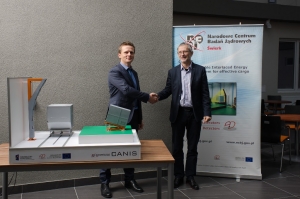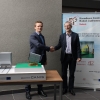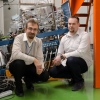NCBJ-developed CANIS cargo scanning system enters the market
2016.10.27 12:54 - admin

Mikołaj Broniszewski, PID Polska President, and Krzysztof Kurek, NCBJ Director General at the ceremony of signing the reached agreement on cooperation (photo Marcin Jakubowski NCBJ)
NCBJ and the PID Polska company have reached a cooperation agreement on commercialization of the NCBJ-developed CANIS Cargo Scanning System. This is a milestone towards commercialization of that unique Hi-Tech technology.
CANIS feasibility was demonstrated within framework of the “Development of Specialized Systems Based on Accelerators and Detectors of Ionizing Radiation for Medical Therapy and in Detection of Hazardous Materials and Toxic Wastes” (aka AiD) project run in NCBJ between 2007 and 2013 under the EU Innovative Economy Operational Programme. Cooperation with the PID Polska company should be an opportunity for Świerk scientist to speed up commercialization of the system. Essential contributions to the complex process of CANIS commercialization have been also made by some officials of National Centre for Research & Development, some officials of Customs Service of the Ministry of Finance, as well as by some PwC company employees.
”CANIS is an innovative, Hi-Tech system for scanning bulky cargo shipped in airfreight containers, trucks, railroad cars etc. without a need to open each container/truck/car and to physically inspect its contents” – explains Dr.Krzysztof Kurek, NCBJ Director General – „Our solution is a very effective tool capable to reveal various goods including hazardous substances smuggled through border checkpoints. That way it may help custom inspectors to fight back smugglers and to increase broadly understood country border security level. The just signed cooperation agreement is undoubtedly a big leap towards a market success for all venture partners. The leap would not be possible without a large involvement of both our scientists and our partners.”
CANIS is a radiographic device i.e. its scans the checked cargo with some high energy X-ray beams. The radiation is machine-produced by a linear electron accelerator. Bunches of electrons are accelerated to some high energy, then abruptly decelerated on some target; pulses of X radiation are emitted in effect. Properly shaped beam of such radiation directed towards the to-be-scanned cargo is detected by a set (a matrix) of detectors placed behind the cargo. Based on intensity of the radiation detected in each element of the detecting matrix, integrated computer is capable to reconstruct 2D images of objects inside the scanned containers without opening them. Physical inspection at border checkpoints/sea ports – an inconvenient and time-consuming action – may be restricted only to suspicious cases.
That well-known principle of operation of a radiographic scanner was improved by NCBJ scientists by introducing two X-ray energies in alternating pulses of radiation; in the CANIS case the two energies are 4 MeV and 6 MeV. Two radiographic images taken virtually simultaneously at two different X-ray energies dramatically improve ability of the scanner to differentiate cargo objects in the displayed images. Cigarettes may be here a key example. As they contain mostly light elements (carbon, nitrogen, oxygen, hydrogen), they are difficult to identify in images taken by ordinary single-energy scanners. However, a well-trained custom officer is capable to almost unmistakably identify them in images taken by dual-energy scanners. The fact that extensive scanner software helps them to process the acquired images using many different image processing algorithms is by no means a minor issue.
Pursuant to the reached agreement, the PID Polska company will be an exclusive supplier of the CANIS Cargo Scanning Systems for the coming 5 years. The agreement may be extended for any period in the future.
Participants of the agreement signing ceremony included Mr.Mikołaj Wroniszewski, PID Polska President; Mr.Łukasz Nikodem, PID Polska Marketing Manager; Ms.Dorota Dębińska-Pokorska, PwC; Dr.Krzysztof Kurek, NCBJ Director General; Dr.Agnieszka Syntfeld-Każuch, NCBJ Deputy Director for Innovations and Implementations; Dr.Jacek Rzadkiewicz, NCBJ Nuclear Techniques & Equipment Department; and others.
The AiD project was accomplished in NCBJ between 2008 and 2013. Total value of the project was 85.5 million PLN, of which 67.5 million PLN was financed by EU from European Regional Development Fund. Demonstrators developed with the project framework included CANIS; the COLINE 6 medical accelerator; the INTRALINE intra-operative medical accelerator; the SWAN neutron system; the INLINE “photon needle” medical accelerator. See more on the AiD project Webpage.
Intense efforts to commercialize numerous results of the AiD project are currently under way in NCBJ. For example, an agreement to develop systems to measure concentration of copper and other metals of interest in the mined ore/processed pulp (fluorescence-based one and neutron activation-based one) was quite recently reached with the KGHM Polska Miedź S.A. company, one of the top ten copper/silver producers in the world.
See the PID Polska company Webpage.



















